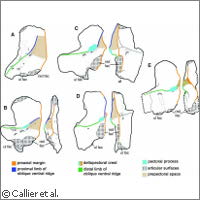Study investigates life histories of earliest known tetrapods
While the fossil record is used to determine the appearance of animals, researchers have identified major differences in the appearance and lifestyle of juvenile and adult animals. But new international research published in Science provides further evidence that some of the earliest backboned land animals experienced a number of lifestyle changes during their maturity. The researchers from Uppsala University in Sweden, Cambridge University in the UK and Duke University in the US investigated the fossil upper-arm bones of the genera Ichthyostega and Acanthostega, the two so-called 'four-legged fishes' from Greenland. The new material showed differing ontogenetic (i.e. showing their development from a fertilised egg to maturity) trajectories for their forelimbs. The animals lived during the Devonian period, a geologic period and a period of the Palaeozoic era spanning from 416 million to 359.2 million years ago. The name is derived from Devon, England, where researchers first studied rocks from this period. It was during the Devonian period that the first fish evolved legs and began to walk on land as tetrapods, i.e. vertebrate animals with four legs. The researchers said Ichthyostega and Acanthostega lived around 365 million years ago and were one of the first vertebrates with forelimbs and hindlimbs instead of paired fins. They are part of the common stem group of all living amphibians, reptiles, mammals and birds, according to the research team. While both are considered the earliest tetrapods known from multiple near-complete skeletons, the Acanthostega is deemed the more primitive. In their study, the researchers found a number of half-grown and fully grown upper arm bones from the two four-legged fishes. They were able to determine how the shape of the bone changed as the animal grew. Based on their analysis, the two animals had varied life histories. 'The upper arm bone provides a lot of information about the lifestyle of the animal, because its shape gives clues [as] to the pattern of movement and can tell us, for example, whether the animal lifted the front part of its body clear of the ground,' explained Professor Per Ahlberg from the Department of Physiology and Developmental Biology at Uppsala University in Sweden. By comparing the two fishes, the researchers found that Ichthyostega is more terrestrial than Acanthostega because it has robust limbs and only a small tail fin. 'The pattern of muscle attachment processes on small humeri (upper arm bones) resembles that in 'fish' members of the tetrapod crown-group condition,' the authors wrote in their paper. It was able to better adapt its forelimb so as to support its weight when mature. Regarding Acanthostega, the small and large humeri show the crown-group pattern; it has feebler limbs and a large tail fin. The researchers found no corresponding changes in this animal. 'The explanation is probably that both animals laid their eggs in water just like modern amphibians, which meant that the terrestrial Ichthyostega, [unlike] the aquatic Acanthostega, needed to undergo a lifestyle transformation as it grew from larva to adult,' Professor Ahlberg said. 'We infer that Ichthyostega underwent greater locomotory terrestrialisation during ontogeny,' the authors said. 'Overall, the relative phylogenetic [evolutionary developmental] positions of Ichthyostega and Acanthostega are best regarded as uncertain; Ichthyostega may well be the more basal [i.e. the one that diverged earlier] of the two.' The placement of the more terrestrially adapted Ichthyostega indicates 'a scenario of rapid early terrestrialisation rather different from the currently predominant "aquatic Devonian tetrapods" model', they said.
Countries
Sweden, United Kingdom, United States



